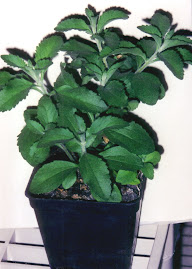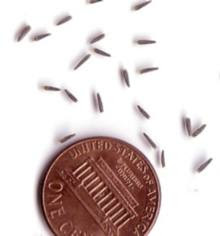
Following is an excerpt from Growing and Using Stevia: The Sweet Leaf from Garden to Table with 35 Recipes.
Stevia Plant Description
Stevia rebaudiana is a fascinating plant, native to higher altitudes of Paraguay and Brazil in South America. Stevia is the genus, meaning a broad classification of plants. Rebaudiana is the species name. When we say “Stevia,” we are referring to this particular species. Only this species, out of the many found in the Americas, contains the high concentration of sweet glycosides making this “sweet leaf” such a useful and amazing herb.
There seems to be something about the Stevia’s glycosides that, despite their appeal to our taste buds, makes many insects loathe to dine on the leaves. Perhaps Stevia rebaudiana developed this high concentration of glycosides as an adaptation to protect itself from insect attack.
Stevia is not a particularly showy plant. Its sweet taste is its most notable feature. It is a non-woody herb, with somewhat stiff and brittle stems. Leaves are small and narrow, notched on the end. Leaves are sweeter than stems. Plants started from seed generally feature larger leaves than plants started from cuttings. Plants usually reach a height of around 24–30 inches (61-76 cm) under cultivation. Older plants can send up new shoots from underground. Stevia blossoms are white and tiny, but so numerous that plants look like greenish-white clouds when in bloom. It is a tender perennial herb, meaning it survives winters and keeps growing, but only where winters are mild, such as subtropical regions like Florida, the gulf coast, and coastal California. Stevia roots will generally not survive under about 25° F. (−4° Celsius).
Stevia and Day Length
Fortunately, Stevia may be grown as an annual— planted every year—where cold winters prevent perennial production. Even when grown as perennials, plants should be replaced every few years since they tend to weaken with time. There are advantages to growing Stevia at higher latitudes, closer to the poles. It has to do with the longer summer day lengths—more hours of sunlight.
(continued below)
Stevia is a “short day” plant which means it blooms as days grow shorter in late summer or fall. In northern Missouri (around 40° north latitude), most Stevia plants don’t bloom until late September or early October. This is when days are finally short enough to trigger blossoming. It means seeds will not ripen outdoors before a killing freeze. But it also means plants can grow all summer with long daylight conditions. Long days have the opposite effect that short days do. They encourage lots of leaf growth rather than blossoms, resulting in higher leaf yields and a higher concentration of sweet glycosides in those leaves. More temperate regions, then, are great for leaf production, but subtropical regions allow for a longer growing season, perennial culture, and outdoor seed production.
See Chapter 1 of Growing and Using Stevia for this additional topic:
Order your copy of Growing and Using Stevia: The Sweet Leaf from Garden to Table with 35 Recipes through one of these links:
directly from Prairie Oak Publishing
from Amazon.com.
###
Stevia Plant Description
Stevia rebaudiana is a fascinating plant, native to higher altitudes of Paraguay and Brazil in South America. Stevia is the genus, meaning a broad classification of plants. Rebaudiana is the species name. When we say “Stevia,” we are referring to this particular species. Only this species, out of the many found in the Americas, contains the high concentration of sweet glycosides making this “sweet leaf” such a useful and amazing herb.
There seems to be something about the Stevia’s glycosides that, despite their appeal to our taste buds, makes many insects loathe to dine on the leaves. Perhaps Stevia rebaudiana developed this high concentration of glycosides as an adaptation to protect itself from insect attack.
Stevia is not a particularly showy plant. Its sweet taste is its most notable feature. It is a non-woody herb, with somewhat stiff and brittle stems. Leaves are small and narrow, notched on the end. Leaves are sweeter than stems. Plants started from seed generally feature larger leaves than plants started from cuttings. Plants usually reach a height of around 24–30 inches (61-76 cm) under cultivation. Older plants can send up new shoots from underground. Stevia blossoms are white and tiny, but so numerous that plants look like greenish-white clouds when in bloom. It is a tender perennial herb, meaning it survives winters and keeps growing, but only where winters are mild, such as subtropical regions like Florida, the gulf coast, and coastal California. Stevia roots will generally not survive under about 25° F. (−4° Celsius).
Stevia and Day Length
Fortunately, Stevia may be grown as an annual— planted every year—where cold winters prevent perennial production. Even when grown as perennials, plants should be replaced every few years since they tend to weaken with time. There are advantages to growing Stevia at higher latitudes, closer to the poles. It has to do with the longer summer day lengths—more hours of sunlight.
(continued below)
Stevia is a “short day” plant which means it blooms as days grow shorter in late summer or fall. In northern Missouri (around 40° north latitude), most Stevia plants don’t bloom until late September or early October. This is when days are finally short enough to trigger blossoming. It means seeds will not ripen outdoors before a killing freeze. But it also means plants can grow all summer with long daylight conditions. Long days have the opposite effect that short days do. They encourage lots of leaf growth rather than blossoms, resulting in higher leaf yields and a higher concentration of sweet glycosides in those leaves. More temperate regions, then, are great for leaf production, but subtropical regions allow for a longer growing season, perennial culture, and outdoor seed production.
See Chapter 1 of Growing and Using Stevia for this additional topic:
- Stevia in The Wild
Order your copy of Growing and Using Stevia: The Sweet Leaf from Garden to Table with 35 Recipes through one of these links:
directly from Prairie Oak Publishing
from Amazon.com.
###




No comments:
Post a Comment